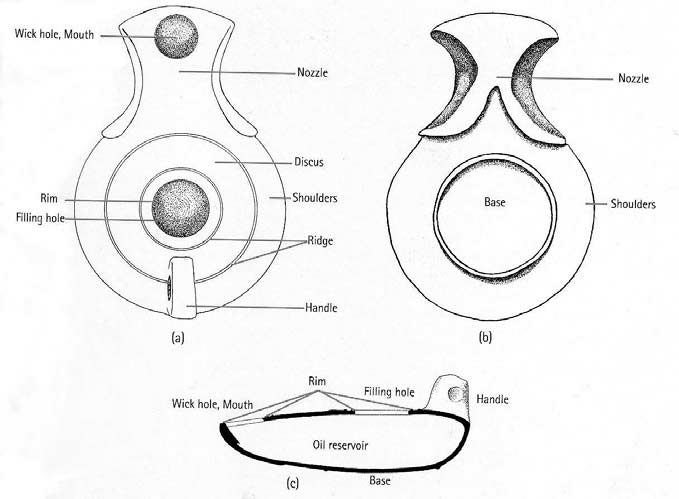Technical Aspects
Parts of a lamp
In order for lamps to work in the most basic sense, they require a wick, fuel, a reservoir for fuel, and an air supply to maintain the flame. More advanced components include the nozzle, discus, shoulders, rim, and the handle. 
How were lamps made?
Lamps could be made from a variety of materials such as stone, clay, shell, glass, and metal. The material used dictated the way in which they were made.
Stone
Stone lamps were typically carved by hand. Early stone lamps were simply stone with natural depressions.
Clay
There are various modes of manufacture for clay lamps. They could be hand-molded, wheel-made, or impressed into a mold. It is even possible for lamps to be made using a combination of these techniques. Clay lamps make up the majority of found artifacts in the archaeological record.
Metal
Earliest metal lamps were made of bronze or iron date back to the Late Bronze Age and Israelite periods, but they did not become common until the Roman/Byzantine periods.
Fuel and Wicks
Fuel types for lamps ranged from animal fat to bees wax to various types of plant-based oils including olive oil, sesame oil, and grape-seed oil. Olive oil is believed to be the primary source of oil for lamps in the Mediterranean Basin. Wicks were any fibrous material such as linen, papyrus, or other plant fibers.
Maker's Marks
A maker's mark is a word or symbol typically found on the base of an artifact, similar to a modern day brand logo. They advertise products of a specific craftsman or workshop to buyers. Archaeologists can use maker's marks to trace the origin of oil lamps.
How did lamps work?
The lamp's reservoir is filled with oil, either animal or vegetable, and the wick is placed from the reservoir to the mouth and then lit. The end of the wick in the reservoir soaks up the oil which is oxidized by the opposite end, allowing it to burn at a constant rate for as long as the lamp had fuel. Sometimes an additional receptacle was fashioned to slowly feed oil into the lamp, or else it would have to be refilled constantly. The wick has to be tended to constantly in order to assure a bright light without smoke. This was achieved by attentively keeping the bulk of the wick submerged in the oil, with only the tip resting in the nozzle.
Uses
Initially, lamps were solely used as a light source, and because they were always relatively small, several had to be used for a sufficient amount of light. A number of excavated lamps have also shown evidence of multiple wicks being used at the same time in the wick hole.
Aside from lighting private homes, public spaces, and places of worship, oil-lamps were also common practice in religious ceremony (both in polytheistic and later, monotheistic tradition) and burials.
